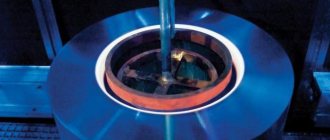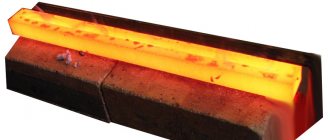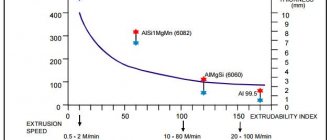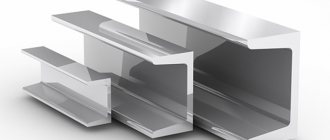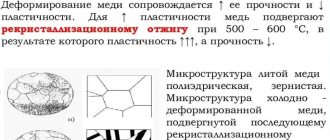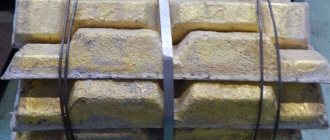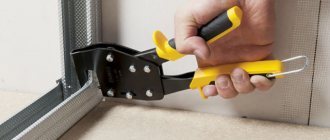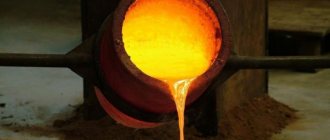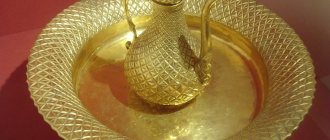Strength, dimensional control and performance are the three main factors taken into account when deciding to produce a competitive aluminum extrusion.
Aluminum alloys are grouped into two categories - thermally non-hardening and thermally hardening. Thermally non-hardening alloys include alloys of the 1xxx, 3xxx and 5xxx series, which achieve their full strength upon subsequent deformation at room temperature. Thermally hardenable alloys - alloys of the 2xxx, 4xxx, 6xxx and 7xxx series - obtain their full strength due to:
- hardening of profiles depending on the temperature at the exit from the matrix (T5 condition);
- hardening of profiles from the temperature of a separate furnace heating in special tanks with water (condition T6).
Aluminum and aluminum alloys
Aluminum as a structural material is rarely used in its pure form.
Small amounts (sometimes less than 1%) of other elements can significantly change its properties, physical and mechanical. One of the main properties of structural metals is their strength. Unalloyed aluminum has a tensile strength of about 90 MPa. Due to strain hardening (hardening), this value can increase to 200 MPa. However, the addition of small amounts of zinc, copper and magnesium to pure aluminum makes it a high-strength aluminum alloy with a tensile strength of more than 550 MPa. Aluminum alloys are divided into two categories: wrought and cast. Wrought alloys are processed into a given shape by deformation (extrusion, rolling, forging, stamping, drawing). Casting alloys are poured into casting molds.
Scope of rental
Due to the characteristics of the material, it is possible to manufacture various rolled parts. They can be used as fuselage elements, spars and other aircraft components. It is used to make controls for aircraft models, as well as components of spacecraft.
Duralumin D16T has become widespread in shipbuilding. Its use has a positive effect on reducing the weight of boats, ships and other vessels. It is used for the manufacture of components with any degree of responsibility.
Road signs, billboards, signs and other elements installed on the street are made using alloy. In the oil industry it is used to produce normal pipes. At the same time, the components and the design as a whole retain their original qualities for 8 years of operation.
The strength characteristics of the composition and steel have a slight difference, while its mass is three times lower compared to steel. Other benefits include:
- ease of transportation;
- ease of processing;
- the possibility of using inhibitors to reduce the corrosive activity of the material.
Rods
Thermal and strain hardening
The properties of an aluminum alloy depend not only on its chemical composition, but also on the history of its thermal and deformation treatments.
Wrought aluminum alloys, the strength of which can be increased by heat treatment, are called heat-hardenable alloys. These alloys include all alloys of the 2xxx, 6xxx and 7xxx series. Sometimes deformation treatment is also applied to these alloys, both before and after heat treatment.
Aluminum alloys of the 1xxx, 3xxx and 5xxx series are not able to increase their strength under the influence of heat treatment. Their strength properties are increased by deformation treatment (hardening).
Most cast aluminum alloys are heat hardenable. Cast aluminum alloys are usually not subjected to cold hardening due to their low ductility.
Corners from AD31T1
Alloys
Corners made of AD31T1 have also become very popular. The characteristics of this alloy made it possible to achieve the following advantages.
Firstly, the light weight of the corners made it possible to significantly reduce the weight of the frame during its creation. Secondly, ductility and ease of processing played a significant role, since the shape can be changed with hand tools if necessary, and after welding small and neat seams will remain. In addition, there is a high level of resistance to various aggressive environmental influences, as well as oxidation. This significantly increased the durability of the corners, which is one of the key factors in the construction of the same frame.
Conditions of aluminum alloys
The level of mechanical properties of any aluminum alloy is determined by two main factors:
- the chemical composition of the alloy, that is, the percentage content of both alloying elements and impurities;
- the state of the alloy, that is, the treatment that the alloy received during the manufacturing process of the finished aluminum product, deformation and thermal.
For conditions that are achieved mainly by heat treatment, the designation consists of a capital letter T and one or more numbers, for example, T66.
For states that are achieved by deformation processing, designations are used that consist of the capital letter H and one or more numbers, for example, H14.
Material characteristics
Avialium refers to compounds that consist of a compound of three metals (Al-Mg-Si). This means that it contains aluminum, magnesium and silicon. This metal is very ductile and rolls well. Such characteristics of AD31T make it possible to make decorative parts from it that are not highly durable.
These properties are imparted by the oxide film that forms on the surface of the material. It protects aluminum from dissolution in sulfur, with the exception of halogens.
The alloy is well suited to color anodizing and powder coating. The material can be pressed to produce hollow semi-finished products for facade structures and pipes.
Properties of AD31T alloy
This type of metal has various modifications. Here are some of the modifications: AD31T1 and AD31T5. The weldability of the AD31T1 is quite satisfactory, as is the case with other modifications. The main characteristics of AD31T1 and AD31T5 are high strength and anti-corrosion. The service life of such metals increases to seventy years.
It has become widespread due to its qualities:
- Non-toxic.
- Corrosion resistant.
- Lasting.
- Electrically conductive (second place after copper).
- Excellent soundproofing material.
- Beautiful appearance.
This alloy has an imported analogue. Its distinguishing feature from ours is its inflated price, and in terms of quality and composition, our alloy was no different before the amendments were made. However, in 2000, amendments were made to GOST 4784-97. Because of them, the chemical composition of the airline had to change slightly.
Finished aluminum product: alloy + condition
When specifying an aluminum alloy as a structural material, it is necessary to indicate both the designation of the aluminum alloy and the state it received in the finished product, for example, in an extruded aluminum profile. Specifying only aluminum alloy for construction material without specifying the condition does not make sense.
In domestic standards, European and American standards, various forms of joint designation of alloy and state are used: continuous, separated by a space, and separated by a hyphen.
For example, in the currently valid GOST 22233-2001, for profiles made of AD31 alloy, the designation “AD31T1” is used (there is no space between the designation of the alloy and the designation of the condition). This means that the AD31 aluminum alloy profile was subjected to complete hardening and artificial aging.
For profiles made from foreign aluminum alloys 6060 and 6063, the designations of the alloy and condition are used, which are accepted in European standards, that is, separated by a space, for example, 6060 T6. This also means that the 6060 alloy profile has been fully hardened and artificially aged.
In American technical literature and American regulatory documents, the alloy and condition are written with a hyphen (not a dash!), for example, 6063-T6.
Technological features
Alloys of this group are characterized by high general corrosion resistance and are not prone to stress corrosion. In a hardened and artificially aged state, the AB alloy is prone to intergranular corrosion. The corrosion resistance of welds is similar to that of the base materials.
The alloys can be satisfactorily welded by spot, roller, and argon arc welding using SvAK5 or ER4043 (Al-Si5) filler wire. The strength of welded joints is 0.6–0.7σ in the base material. Subsequent hardening and aging increase the strength to 0.9–0.95σv of the base material.
Cutting machinability in the annealed state is unsatisfactory, while in the heat-treated state it is satisfactory.
Aluminum alloys for aluminum profiles
Russian SP 128.13330.2012 (updated SNiP 2.03.06-85) prescribes the following deformable aluminum alloys for use in building aluminum profiles: AD31, 6060, 6063, AD33, AB, 1915, 1925, V95.
Eurocode 9 uses alloys 5083, 5454, 5754, 6060, 6061, 6063, 6005A, 6106, 6082, 7020 for aluminum profiles.
Russian SP 128.13330.2012 and European Eurocode 9 “intersect” on alloys 6060, 6063, AD33 (6082) and, partially, on alloys 1915 and 1925 (7020).
Note that Eurocode 9 does not use high-strength alloys such as 7075 (analogous to alloy B95). In addition, Eurocode recommends three alloys of the Al-Mg series (5xxx) for aluminum profiles. SP 128.13330.2012 does not contain such alloys for profiles.
Chemical composition
6082 Aluminum Alloy Composition:
Chemical composition of aluminum 6082
| Element | Weight percentage (%) |
| Aluminum | 95,2–98,3 |
| Chromium | 0.25% max. |
| Copper | 0.1% max. |
| Iron | 0.5% max. |
| Magnesium | From 0.6 to 1.2% |
| Mangenese | From 0.4 to 1.0% |
| Silicon | From 0.7 to 1.3% |
| Titanium | 0.1% max. |
| Zinc | 0.2% max. |
| leftovers | 0.15% max. |
Alloys for profiles of enclosing structures
Profiles for building envelopes - windows, doors, facades - are distinguished by a complex cross-sectional shape, including rather thin walls and shelves, grooves for seals and thermal inserts. In addition, these profiles require increased accuracy of cross-sectional dimensions, as well as shape, transverse and longitudinal. Therefore, only aluminum alloys 6060 and 6063 (AD31) are usually used for their manufacture.
The content of the main alloying elements of these alloys - magnesium and silicon - is shown in Figure 1. For comparison, other alloys of the 6xxx series are shown - medium alloyed alloy 6005 and highly alloyed alloys 6061 and 6082.
Figure 1 – Magnesium and silicon in alloys of the 6xxx series
The main advantages of aluminum alloys of the 6060, 6063 and AD31 series are that they are easily pressed and can be fully hardened directly on the press to achieve the maximum strength T6 state using only air cooling.
Technical specifications
Among rolled aluminum products, duralumin sheet and wire D16chAT, D16chAm are especially popular. They are used in the production of door and window blocks, frames, and in construction (roofing, flooring). Duralumin has excellent resistance to the destructive effects of the external environment, such as:
— temperature changes;
- ultraviolet radiation;
- the effect of moisture.
Percentage composition (GOST 4784−97)
| Fe | Si | Mn | Cr | Ti | Al | Cu | Mg | Zn | Ti+Zr | Impurities |
| ≤0.5 | ≤0.5 | 0.3 — 0.9 | ≤0.1 | ≤0.15 | 90.9 — 94.7 | 3.8 — 4.9 | 1.2 — 1.8 | ≤0.25 | ≤0.2 | ≤ 0.15 |
What does the marking mean: D16chAM, D16chAT? D - duralumin, 16 - average magnesium content in tenths of a percent, M - means that the material was subjected to additional heat treatment (annealing), as a result it became more plastic and soft. Further, duralumin semi-finished products are marked as follows. normal cladding - A, technological cladding - B, unclad - do not have an additional designation. The quality of finishing is standard, the strength and precision of workmanship is normal. They are classified according to the condition of the material: hot-pressed semi-finished products - without additional heat treatment, as well as hardened and naturally aged - T. Products that have been hardened should not have any traces of burnout. After completion of heat treatment, duralumin samples are tested. The letter T at the end of the marking means that the material has been successfully heat treated, naturally aged and more durable. It is used for the production of power structural elements.
Strength properties t =20°С
| Assortment | GOST | sв | sT | d5 | y | Heat treatment |
| — | MPa | MPa | % | % | — | |
| Pipes, GOST | 18482−79 | 390−420 | 255−275 | 10−12 | ||
| Rod Ø 8 – 300 | 21488−97 | 390−410 | 275−295 | 8−10 | Hardening and aging | |
| Rod, high strength, | 51834−2001 | 450−470 | 325−345 | 8−10 | Hardening and aging | |
| Annealed tape | 13726−97 | 235 | 10 | |||
| Profiles, 10 – 150 mm | 8617−81 | 412 | 284 | 10 | Hardening and artificial aging | |
| Plate | 17232−99 | 345−420 | 245−275 | 3−7 | Hardening and aging |
Application
Construction of reliable lightweight building structures, creation of frames for high-speed trains, airplanes, cars. Duralumin pipe is often used for facade fragments, laying special-purpose pipelines, and industrial pipelines. In addition, duralumin pipes and sheets are in demand in the aviation and automotive industries; they are difficult to replace in the manufacture of road signs and billboards. Duralumin wire is no less popular on the market; its main consumers are the fuel and chemical industries. To improve the corrosion resistance of rolled duralumin, as a rule, they are planked, and for pipes, oxidation and inorganic inhibitors are used.
The role of magnesium and silicon in alloys of the 6xxx series
Magnesium and silicon are the main alloying elements in all 6xxx series aluminum alloys. Magnesium and silicon are included in the compound magnesium silicide (Mg2Si) in a ratio of 1.73 to 1 (Figure 1). It is magnesium silicide that makes 6xxx aluminum alloys thermally hardenable. The level of strength properties of these aluminum alloys depends mainly on the number, size and uniformity of distribution of Mg2Si clusters or particles in aluminum.
Based on the magnesium content in the alloy, the amount of silicon that it will “bind” in magnesium silicide is determined: %Si = %Mg/1.73. For example, if the magnesium content in the alloy is 0.45%, then 0.45/1.73 = 0.26% silicon is required to form magnesium silicide. Part of the silicon is associated with iron and manganese in the primary Al(FeMn)Si particles, which are formed during the casting of the pillars. This amount of silicon is estimated as a third or a quarter of the total content of iron and manganese: 1/4 (Fe + Mn). The rest of the silicon is excess.
general description
To begin with, it is worth saying that AD31T1 is an alloy in which there are three main elements. These elements are Mg–Al–Si, in other words, it is an alloy of magnesium, aluminum and silicon. According to its characteristics, AD31T1 belongs to the group of deformable aircraft. Among other similar materials, it differs favorably in that it has high ductility. In addition, it has fairly high technological properties and high corrosion resistance. It should be added that this alloy lends itself well to mechanical processing such as stamping, rolling, drawing and many others. The main purpose of this raw material is to produce parts with good decorative characteristics and a small margin of safety.
Aluminum alloy 6060
- Has a minimum magnesium content of 0.35%, and silicon - 0.30%
- "Diluted" version of alloy 6063
- In T6 condition it provides pressed profiles (up to 3 mm thick) with a minimum strength of 190 MPa
- Easily pressed even with very complex profile cross-sections.
- It is well shaped, for example, flexible, in T4 condition - after hardening and natural aging.
- They are used in windows, doors, facades, as well as in the manufacture of handrails, fences, furniture, and sports equipment.
- Well suited for anodizing – protective and decorative.
Aluminum alloys 6063 and AD31
- The minimum content of magnesium is 0.45%, and silicon - 0.20%
- The increased minimum of magnesium provides higher strength than alloy 6060: in T6 condition - up to 215 MPa
- The increased magnesium content reduces the pressing speed: by 15-20% compared to alloy 6060
- The scope of application is the same as that of alloy 6060, except for complex and thin-walled profiles, when it is recommended to use alloy 6060.
Designations
- EN 573-3 :
EN AW-6063 - US standard ANSI H 35.1 :
6063 - Teal Sheet (Aluminum Association): 6063
- Unified Numbering System (UNS) :
A96063 - ISO 209 :
6063 (until 2007 according to ISO 209-1 - AlMg0.7Si) - Japan: A6063
- DIN 1725-1
(cancelled): not available
Aging of aluminum alloys: natural and artificial
Typically, natural aging begins immediately after hardening at a relatively high rate, which then gradually decreases (Figure 2). Depending on the alloy, it may take several weeks to reach the T4 state, such as for alloy 6060 with a minimum of magnesium and silicon content. For alloy 6063, which has the highest magnesium and silicon content, this process is virtually complete within about a week.
Figure 2 – Aging of aluminum alloys (not to scale) [3]
Some time after hardening - several hours or days, depending on the alloy and production conditions - the profiles that must be artificially aged are placed in an aging oven. A typical artificial aging regime for profiles made of alloy 6060 is heating to a temperature of 180 ºC and holding for 5 hours to achieve T6, as well as T5 or T66 conditions. At the same time, they try to get to the maximum strength on the aging curve.
With longer aging, the strength of the profiles decreases and then the result is overaged
condition T7.
This condition provides increased electrical conductivity. With a shorter exposure, the material receives an under-aged
state, for example, T64.
Increased ductility
Tsam alloys - composition, properties and scope of application
Alloys of the Al-Mg-Si system are widely used in production due to their complex of valuable properties. Alloys AD31, AD33, AD35, AD and 6000 series have good corrosion resistance, manufacturability, high ductility in the hot state, and alloy AB - in the hot and cold state. These alloys are subjected to color anodizing, enameling, and enamelling. When hot, they are used to produce profiles, blanks and semi-finished products of complex shapes.
Corrosion-resistant Al-Mg-Si alloys are ductile in the annealed, freshly quenched and naturally aged state. Alloys are stamped, drawn and deformed to significant degrees. Compared to the ductile alloys AMg5 and AMg6, alloys AD31, AD33, AD35, AD and 6000 series are weakly cold-worked and hardened during cold deformation, which reduces or eliminates intermediate annealing at high degrees of deformation.
Alloys are strengthened by heat treatment according to the following modes: hardening (heating at t
=515-525°C, cooling in cold water), natural aging at room temperature for about 10 days;
hardening, artificial aging at a temperature of 160-170°C for 10-12 hours. Annealing of semi-finished products is carried out at temperatures of 350-370°C (AD35, AB); 350-400°C (AD31); 380-420°C (AD33). This is followed by cooling in an oven at a rate of 30°/h to t
= 250°C, followed by further cooling in air.
Conditions of profiles made of alloys 6060, 6063 and AD31
The state of the aluminum alloy reflects the processing history of the material of the aluminum product or semi-finished product (deformation and/or thermal). The chemical composition of the alloy and its condition uniquely determine the structure of the material and its mechanical properties.
GOST 22233-2001 applies the following conditions for the AD31 alloy:
- T – hardened and naturally aged;
- T1 – hardened and artificially aged;
- T5 – not completely hardened and artificially aged;
- T1(22) and T1(25) – hardened and artificially aged with increased strength.
For international alloys 6060 and 6063, the following conditions apply:
- T4 – hardened and naturally aged;
- T6 – hardened and artificially aged;
- T5 – not completely hardened and artificially aged;
- T64 - hardened and artificially aged (underaged);
- T66 - hardened and artificially aged with increased strength.
Condition T5
Incomplete hardening of profiles can occur in the following cases:
- when hardening on a press from a temperature below the temperature of complete dissolution of alloying elements;
- if the cooling rate of the profile at the exit from the press is not high enough;
- for “gentle” cooling of thin-walled or complex profiles to prevent their warping.
Conditions T4 and T6
Formally, conditions T4 and T6 include quenching from a separate furnace heating. However, in practice, these states are obtained by hardening on a press. In this case, unlike the T5 state, the temperature of the profiles at the exit from the matrix and the cooling rate of the profiles must be monitored.
Condition T66
Condition T66 is a T6 condition with increased strength properties. These improved mechanical properties are achieved through special measures, for example, more stringent control of the cooling rate of the profiles or a narrower range of alloy chemical composition.
Increased ductility
Alloys of the Al-Mg-Si system are widely used in production due to their complex of valuable properties. Alloys AD31, AD33, AD35, AD and 6000 series have good corrosion resistance, manufacturability, high ductility in the hot state, and alloy AB - in the hot and cold state. These alloys are subjected to color anodizing, enameling, and enamelling. When hot, they are used to produce profiles, blanks and semi-finished products of complex shapes.
Corrosion-resistant Al-Mg-Si alloys are ductile in the annealed, freshly quenched and naturally aged state. Alloys are stamped, drawn and deformed to significant degrees. Compared to the ductile alloys AMg5 and AMg6, alloys AD31, AD33, AD35, AD and 6000 series are weakly cold-worked and hardened during cold deformation, which reduces or eliminates intermediate annealing at high degrees of deformation.
Alloys are strengthened by heat treatment according to the following modes: hardening (heating at t
=515-525°C, cooling in cold water), natural aging at room temperature for about 10 days;
hardening, artificial aging at a temperature of 160-170°C for 10-12 hours. Annealing of semi-finished products is carried out at temperatures of 350-370°C (AD35, AB); 350-400°C (AD31); 380-420°C (AD33). This is followed by cooling in an oven at a rate of 30°/h to t
= 250°C, followed by further cooling in air.
Eurocode 9 – European Standard EN 1999
The European standard EN 1999-1-1, which is part of the EUROCODE 9 or Eurocode 9 series of standards, defines the general rules and regulations for the use of aluminum alloys in building structures. Eurocode 9 is, in turn, part of a series of European standards for construction under the general name Eurocode (EUROCODE).
The European standard EN 1999-1-1 in the countries of the former USSR has the following status:
- in Russia – a national application is being prepared;
- in Ukraine – the standard DSTU-N B EN 1999-1-1:2010 was adopted
- in Belarus – the technical code of established practice TCH EN 1999-1-1-2009 was adopted.
